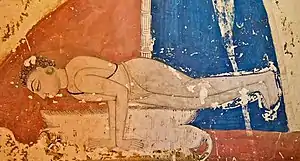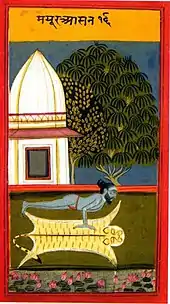Mayurasana
Mayūrāsana (Sanskrit: मयूरासन) or Peacock pose[1] is a hand-balancing asana in hatha yoga and modern yoga as exercise with the body held horizontal over the hands. It is one of the oldest non-seated asanas.


Etymology and origins

The name comes from the Sanskrit words mayūra (मयूर) meaning "peacock"[2] and āsana (आसन) meaning "posture".[3]
Mayurasana is one of the oldest non-seated asanas used in hatha yoga; it is first described in the 10th century Vimānārcanākalpa. The Vāsiṣṭha Saṁhitā 1.76-7 states that it destroys all sins.[4]
Description
In this asana the body is raised like a horizontal stick holding the floor with both palms while the body is supported by the elbows.[5]
Variations
Hamsasana (Swan Pose) is identical to Mayurasana except that the hands are placed with the fingers pointing forwards.[6]

Padma Mayurasana (Lotus in Peacock Pose) has the legs crossed as in Lotus Position.[7]
See also
- List of asanas
- Planche (exercise)
- Vrischikasana, scorpion pose, with variations including Pincha Mayurasana
References
- "Yoga Journal - Peacock Pose". Retrieved 9 April 2011.
- "Mayurasana - AshtangaYoga.info". Retrieved 9 April 2011.
- Sinha, S. C. (1 June 1996). Dictionary of Philosophy. Anmol Publications. p. 18. ISBN 978-81-7041-293-9. Retrieved 9 April 2011.
- Mallinson, James; Singleton, Mark (2017). Roots of Yoga. Penguin Books. pp. 100–101, 105. ISBN 978-0-241-25304-5. OCLC 928480104.
- Iyengar 1979, pp. 282–284.
- Iyengar 1979, pp. 284–285.
- Ramaswami, Srivatsa; Krishnamacharya, T. (3 June 2005). The complete book of vinyasa yoga: an authoritative presentation, based on 30 years of direct study under the legendary yoga teacher Krishnamacharya. Da Capo Press. p. 208. ISBN 978-1-56924-402-9. Retrieved 9 April 2011.
Sources
- Iyengar, B. K. S. (1979) [1966]. Light on Yoga: Yoga Dipika. Unwin Paperbacks. ISBN 978-1855381667.
_from_Jogapradipika_1830_(cropped).jpg.webp)
